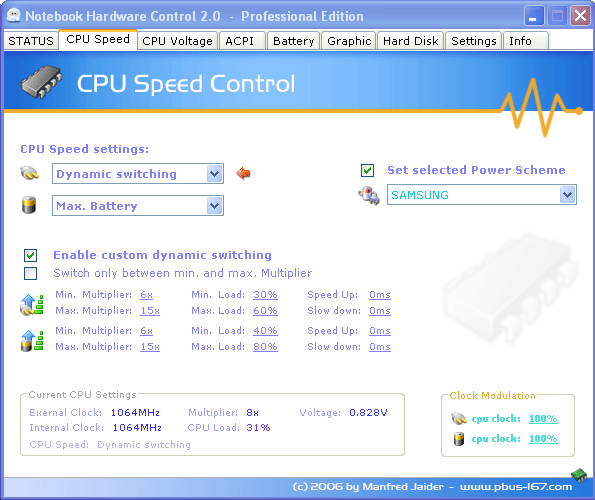4
1
How to slow down my laptop cpu so that it does not overheat?
4
1
How to slow down my laptop cpu so that it does not overheat?
4
This answer is only for Windows, not for Linux.
You could use Notebook Hardware Control to set dynamically a profile to use for the CPU speed.
Even if you are using a lot of programs requesting cpu time, it will force the cpu speed to what you set (in the regular steps; there are options also to set the clock speed yourself, but discouraged and unnecessary).
For some compatible graphical cards, you will also be able to apply the same limitations, for example to force the gpu to run only on half speed.

NHC is freeware. Note however that even though a new version is supposed to be coming "soon", this program hasn't been updated for a while
+1 even if it hasn't been updated, looks interesting. – William Hilsum – 2010-05-26T10:03:28.793
-1 for missing the Linux tags. – Bobby – 2010-06-10T14:24:40.580
@bobby - And that's why I put a disclaimer on top of my answer after I noticed the tag. I chose to leave the answer, seeing as it was useful anyway to at least one person. – Gnoupi – 2010-06-10T14:53:37.420
2
Most laptops do not allow access to voltage and frequency through bios, in which case you may be unable to complete your task.
If you are lucky enough to have a laptop allowing access, however, then the task is relatively simple. Beware that doing the following wrong has the capability to cause problems, void your warrenty, or even wreck your computer indefinitely. It is highly recommended you read around about overclocking/underclocking before attempting it. Go into your laptop BIOS (Usually DEL while booting, sometimes different. Watch the boot screen) and look for Frequency/Voltage control. See if you are able to lower your BCLK, or your CPU multiplier. Drop that to whatever CPU Speed you are looking for. Afterwards, drop your voltage down a little bit, and boot. If your computer remains stable, you can lower your voltage again. Make sure, however, that you remain at a stable voltage, otherwise your laptop may randomly blue screen, restart, or worse.
However, if you are unable to access these commands in bios, look for fan settings in bios, and max them to 100% at all times. If they aren't there, download Speedfan, and see if it can change your fan speeds.
If all else fails, get a nice laptop cooling mat. Targus, and many other companies make them, and they can be found at many locations, including Walmart.
I hope you resolve this heat problem ;)
Speedfan has no Linux version. – Bobby – 2010-06-10T14:25:58.193
1
Probably the most natural way is to use the program cpufreqd. After installing, test with cpufreq-info if your CPU(s) are clocked down (the default profile should be "ondemand", which means, if you need it, it will maximize the CPU speed, otherwise it is on lowest).
cpufreqd might work only for Intel CPUs. If you got an AMD, use powernowd instead.
0
On linux you have cpufreq-set command ('cpufrequtils' package) and cpupower (linux-tools-common package). For 2GHz max:
sudo cpufreq-set -u 2.0
or
cpupower frequency-set -u 2000
Arch Wiki have a greate article.
jupiter: With GUI, but for old disros -->
- powertop
- Check TLP from askubuntu: tlp - apply laptop power management settings
- sudo apt install tlp && sudo tlp start
- wget https://raw.githubusercontent.com/silverjam/Sysmods/master/scripts/indicator-TLP.py && python2 indicator-TLP.py
- indicator-cpufreq
What kind of laptop and processor? – Earlz – 2010-05-26T00:35:03.197
If your laptop is overheating, you have a problem somewhere. Lowering your CPU speed may stop the symptoms for a period of time, but it is by no means a solution. – MDMarra – 2010-06-10T14:36:28.783